The case of the dying newts: an Olympic Peninsula mystery

I
can’t tell you where I interviewed Max Lambert, but I can tell you what we saw.
It wasn’t pretty.
Lambert is a research scientist with the Washington Department of Fish and Wildlife. He has been keeping an eye on a remote lake on the Olympic Peninsula, where a once-abundant amphibian has been turning up dead, littering the lakeshore with tiny carcasses.
Something is killing the lake’s population of rough-skinned newts.
Amphibian populations in much of the world have been collapsing, in what has been dubbed the “amphibian apocalypse.”
Many of the froggy victims have apparently been felled by a type of invasive fungus known as chytrid.
Lambert has been trying to figure out if a salamander-eating chytrid has made its unwelcome first appearance in North America. So far, he hasn't found hard evidence of the deadly fungus. Still, Lambert asked me not to reveal the lake’s name so curious visitors don’t flock there and make a dire situation even worse for the newts.
Sponsored
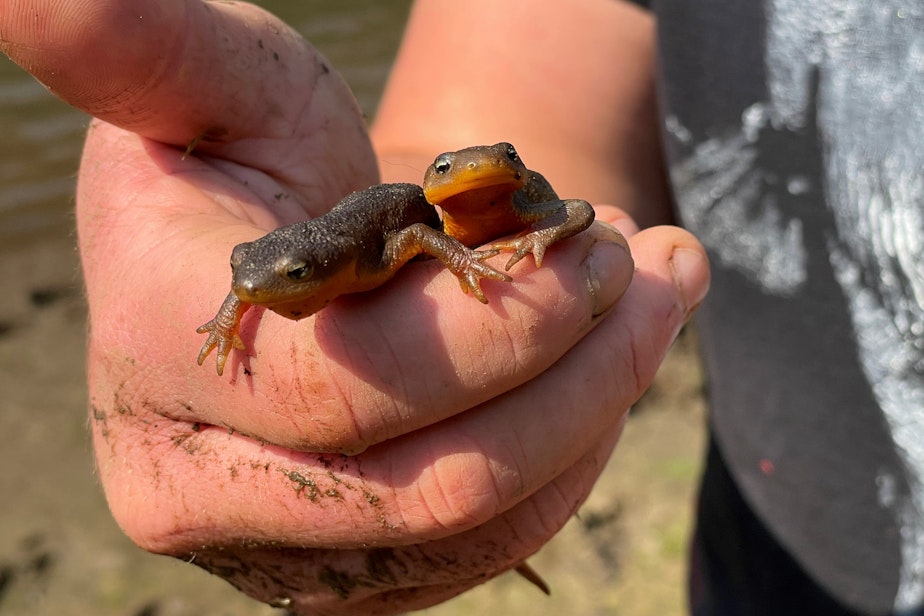
R
ough-skinned newts are one of the more common amphibians in Washington, Oregon, and California. They’re little salamanders with short legs, very long tails, and bright orange bellies. They’re small enough to hold two in your hand at the same time.
If you do, wash your hands afterward. The newts’ skin contains tetrodotoxin — the same nerve poison found in fugu pufferfish, the dangerous seafood delicacy in Japan.
When threatened, rough-skinned newts will arch their necks and tails to show off their unusual orange undersides, as if to tell potential predators, “I’m poison, remember?”
Sponsored
On a sunny, smoky day in September, Lambert tromps barefoot through deep mud at the edge of the small lake to look for newts.
“Last year, I started coming here in summertime. I probably saw a couple thousand newts in this pond,” Lambert says. “It was teeming. You couldn't look across the water without just seeing newts crawling all over.”
A year later, newts are few and far between.
Lambert finds one. It’s dead.
Scattered around the shore of the lake are little bodies: carcasses of newts in various stages of desiccation and decomposition.
Sponsored
“You don’t see dead newts very often in a relatively pristine mountain lake in the Olympic Peninsula,” Lambert says. “Seeing something like this at the water’s edge, a dead newt, is uncommon. It’s very weird. It is worrisome.”
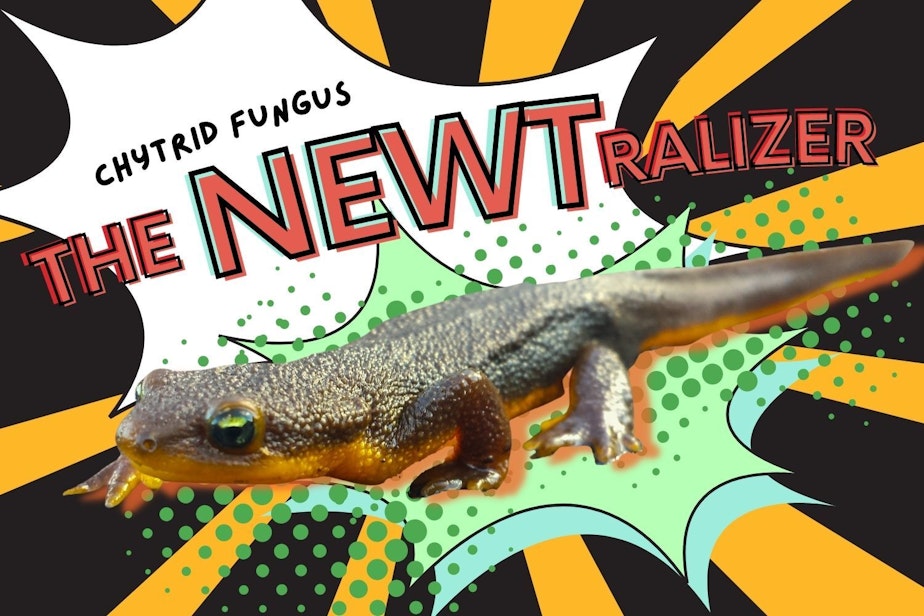
I
n a sense, newts and other amphibians are like tiny salmon, though they get much less attention. Salmon spend most of their lives at sea but return to land to spawn and die. They deliver nutrients from afar as their bodies decompose or are eaten.
Just the same, amphibians hatch in water bodies, while adults often roam the uplands. Rough-skinned newts make annual migrations of a mile or more to breed and lay eggs.
Sponsored
“They help refertilize the landscape,” Lambert says. “If we lose this, we don't have another option for getting that back out there.”
Beyond that ecological service, Lambert says amphibians benefit humans directly as well.
“Without them, we can imagine a ton more flies and mosquitoes out there bothering us when we're out enjoying nature,” he says.
Researchers recently linked an increase in malaria cases in Costa Rica and Panama to chytrid fungus tearing through the frog populations of Central America, leaving malaria-carrying mosquitoes with fewer predators.
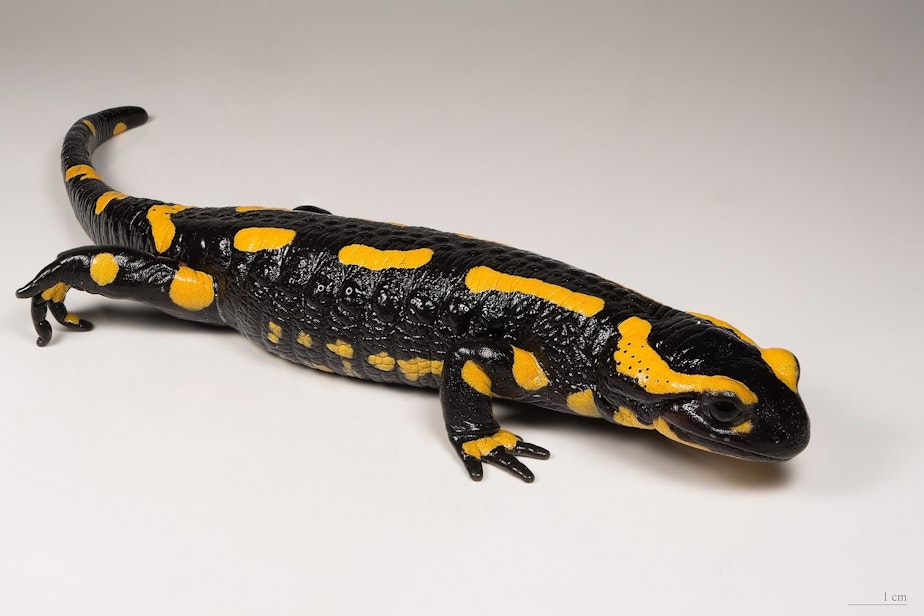
Sponsored
T
he invasive chytrid known as Bd (short for the nearly unpronounceable Batrachochytrium dendrobatidis) has been killing frogs around the world for a quarter century or more. The fungus has wiped at least a few frog species off the face of the earth and endangered many others.
How many is debated. Some scientists say Bd has harmed more than 500 frog species, pushing many close to extinction. Other researchers, including Lambert, agree that Bd is a severe global threat but say clear evidence of its amphibicidal role is often lacking when so many other factors — from habitat loss to climate change — also prey on frogs.
A sister species of chytrid was only discovered in 2013. It has decimated the photogenic fire salamander (with the charming scientific name Salamandra salamandra) in much of Europe.
The fungus even has “salamander-eating” in its scientific name: Batrachochytrium salamandrivorans. It’s called “Bsal” for short.
Bsal was first found near Amsterdam, a world center of international trade in amphibians for pets and for food, and is believed to be native to Southeast Asia. From 2010 to 2014, the United States imported nearly 800,000 salamanders, mostly from Asia, according to University of California researchers.
British epidemiologist Matthew Fisher calls Bsal “the perfect pathogen”: virulent, able to infect multiple host species, and able to survive long stretches between hosts as a thick-walled spore.
“When I started seeing these newts, I was horrified that maybe Bsal finally got here and was doing some damage,” Lambert says on the lakeshore. “We don't know it's here yet. But that's what I'm worried about.”
Laboratory studies have shown that Bsal is especially lethal to newts.
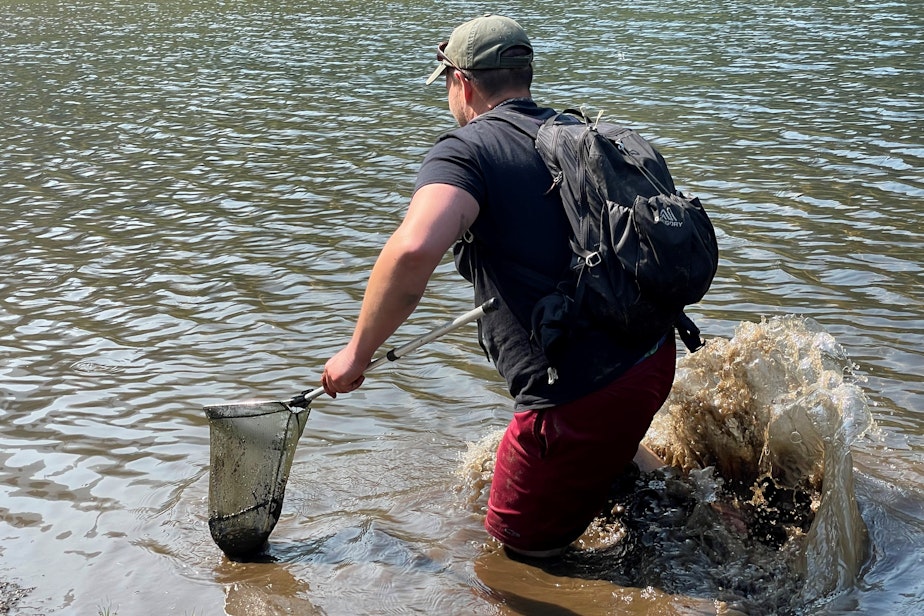
Lambert sees a newt swimming and lunges into the lake to catch it. He nets the newt, then cups it gently in his hand to examine it.
This one is emaciated. It looks like somebody shrink-wrapped skin against a skeleton.
“They can’t breathe properly. Just sad, sad critters,” Lambert says while looking at the dying animal perched on two of his fingers. “Hard to imagine he’ll make it very long.”

 29 secs
Washington Department of Fish and Wildlife biologist Max Lambert holds a dying newt on Sept. 9. at a lake on the Olympic Peninsula.
29 secs
Washington Department of Fish and Wildlife biologist Max Lambert holds a dying newt on Sept. 9. at a lake on the Olympic Peninsula.
O
ne small lake losing its population of a common species may seem like a small thing. But the stakes are high if Bsal shows up there.
The United States is home to more species of salamanders —about 211— than anywhere else in the world.
“Introduction of Bsal to North America could have severe impacts on biodiversity and amphibian conservation,” according to the U.S. Geological Survey.
The southern Appalachians are the global hotspot of salamander diversity, but researchers say the coastal Northwest, with its mild, wet climate, is another high-risk zone for a Bsal invasion and salamander die-off.
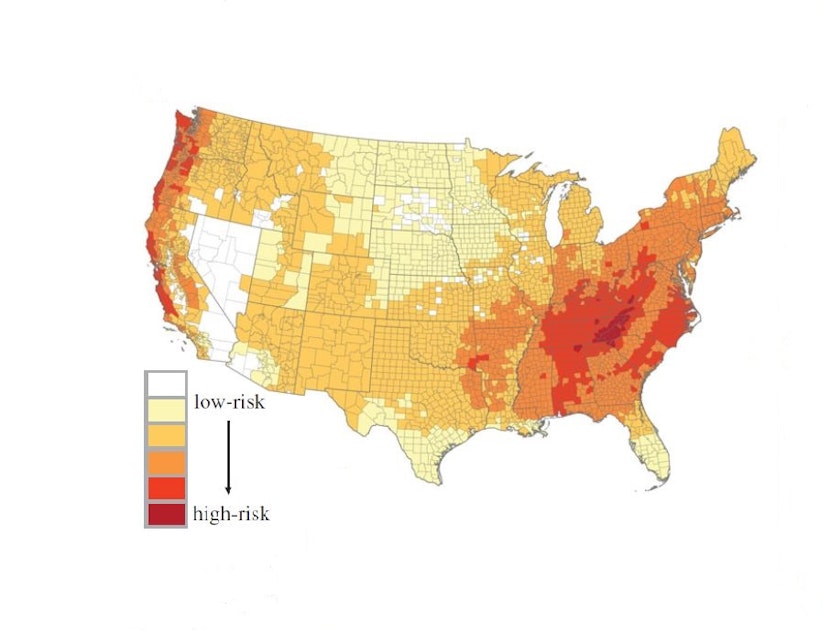
F
orty percent of the world’s amphibian species are considered threatened with extinction — more than other vertebrates, like mammals, birds, or fish. Amphibians face a litany of threats: habitat loss, water pollution, the wildlife trade, invasive predators, and climate change.
When biologists work to save these species, they have to make sure they’re not adding a deadly fungus to the mix.
At Northwest Trek Wildlife Park, midway between Olympia and Mount Rainier, zookeepers have been raising northern leopard frogs for reintroduction to the wild. The little spotted amphibians are an endangered species in Washington.
Zookeeper Armando Valenzuela lifts a lid off an outdoor water tank with 40 tiny frogs in it and shakes out a bag full of live crickets — frog food.
“I'm just feeding 500 crickets to them,” Valenzuela says. “They're going to start to eat right away because they’re kind of hungry.”
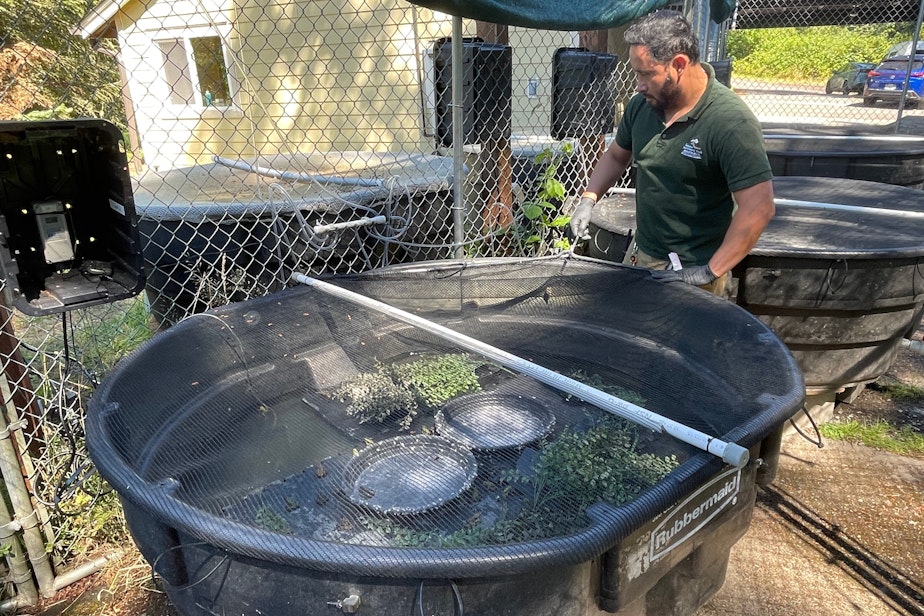
The leopard frogs are destined for release in the Columbia National Wildlife Refuge near Othello, Washington. To make it there, they have to be protected from enemies as large as ravens and as small as single-cell fungi.
The lid, fences, and overhead netting protect the young frogs from ravens and invasive bullfrogs, both of which can be heard in the nearby woods.
The whole frog-rearing operation is tucked away in a corner of the wildlife park, outside the house where park interns live, to protect the leopard frogs from disease.
“Chytrid fungus is definitely a concern for all amphibian species,” zoological curator Marc Heinzman says. “That's one of the reasons why we have our frogs here raised quite a distance away physically from the rest of our animals.”
Staff who take care of the frogs only take care of these animals. The same goes for equipment and tools.
“We really do what we can to limit any sort of cross-contamination,” Heinzman says.

A
t the undisclosed lake, Max Lambert has a scientific mystery on his hands. Why are animals dying at a seemingly pristine lake, with no roads, buildings, or pollution sources nearby?
In July, the Washington Department of Fish and Wildlife stocked the lake and many others with rainbow trout for recreational anglers to catch, as it has every few years for decades. Introduction of a predatory fish can spell disaster for most amphibians, but trout wisely leave the toxic-skinned newts alone.
Fish and Wildlife representatives say hatchery managers monitor fish eggs and fish for a variety of fish pathogens and regularly disinfect gear, facilities, and transport vehicles to avoid spreading disease.
They do not monitor for chytrid.
“There are too many microbes/pathogens in existence to evaluate for all of them, especially when the fungus in question is not known to cause disease in [salmon and trout],” Fish and Wildlife spokesperson Ben Anderson said by email.
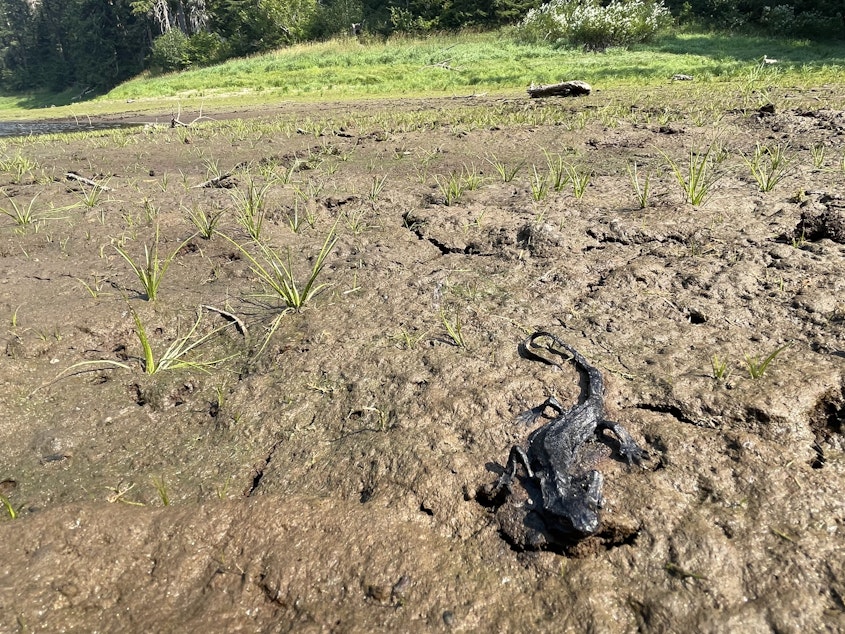
A warming climate can put some pathogens in overdrive, enabling them to expand their ranges into formerly colder territories. That’s apparently not the case for chytrid fungus.
“It’s tricky,” says Jonah Piovia-Scott, a biologist at Washington State University-Vancouver. “Bd and Bsal don’t tolerate warmer temperatures. Above approximately room temperature, those pathogens start to do quite poorly.”
Still, hotter temperatures and drier summers can weaken many amphibians, leaving them more susceptible to pathogens.
“In these animals’ habitats, drought conditions force animals closer together,” Piovia-Scott says.
Less distancing can mean more disease spreading.
“That water is plenty deep,” Lambert says at the lake. “It's plenty cool, so they aren't overheating. They certainly aren't starving due to lack of food.”
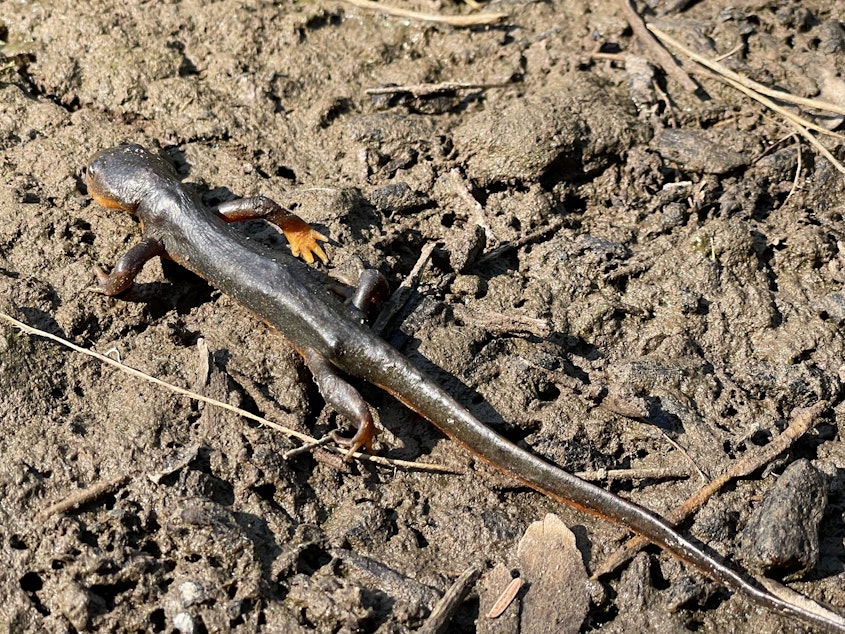
He first saw shriveled and dead newts at the lake in 2021. Lambert says their little bodies decompose fast, destroying evidence of what did them in.
“Detecting those molecules of a virus, or bacteria, or fungus becomes very, very hard,” Lambert says. “So it makes it very hard to study disease, if that's what's happening out here, because getting a good sample that's clean is really challenging.”
Lambert lifts a small chunk of rotten wood off the ground and finds the remains of another newt.
“You can see here’s one that tried to take shelter but clearly died and is liquified there,” he says. “Could not get a sample off of that.”
Poor-quality samples Lambert obtained in 2021 were inconclusive.
“It's kind of like taking a Covid test and coming back with a question mark next to it,” he says.
After our September 2022 visit to the lake, Lambert shipped dead newts (preserved in alcohol) and live newts (inside a plastic food-storage container, along with wet paper towels to keep the animals’ skin moist) to the Washington Animal Disease Diagnostic Laboratory at Washington State University.
The laboratory found no evidence of chytrid fungus or other potential causes of death.
So the sudden die-off remains an Olympic Peninsula mystery, and Bsal, the deadly salamander-eating fungus, has yet to be spotted in North America.
U.S. officials want to keep it that way.
In 2016, the U.S. Fish and Wildlife Service banned imports and interstate transportation of 201 species of salamanders known to be capable of carrying Bsal.
But fungal spores can hitch a ride in lots of ways. Bsal’s floating spores are even able to stick onto the feet of visiting waterfowl.
Max Lambert says he’s concerned that anyone fishing with live bait at the lake could slosh or dump Bsal-tainted water into it.
For his part, Lambert says he bleaches his gear between lake visits to avoid harming the little animals he’s trying to save.
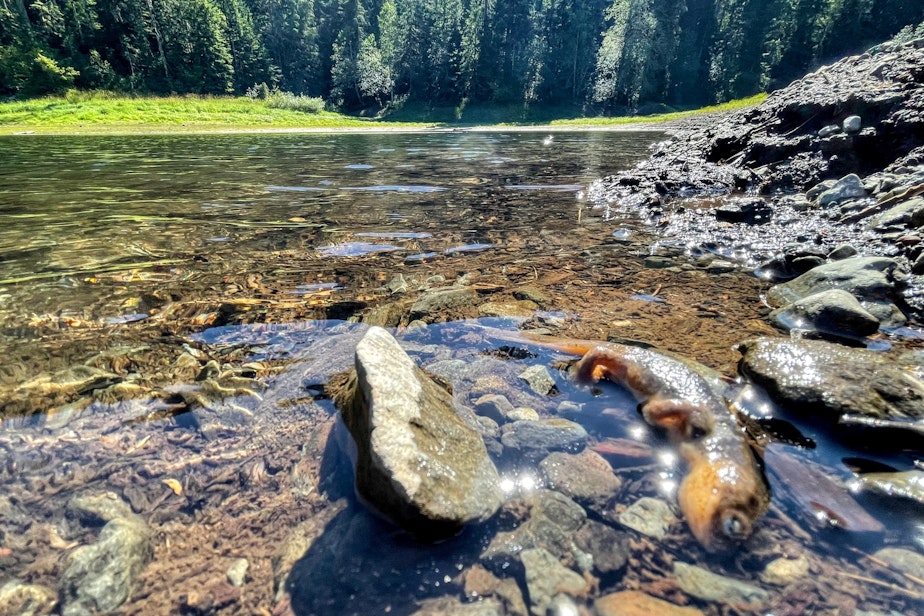
This story is Part 3 of our series on invasive species in Washington state: “KUOW's League of Murder Creatures.”
Correction 11/16/22 4:15 p.m.: An earlier version attributed an emailed statement to the wrong Washington Department of Fish and Wildlife official.




